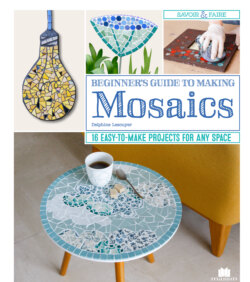Читать книгу Beginner's Guide to Making Mosaics - Delphine Lescuyer - Страница 7
На сайте Литреса книга снята с продажи.
ОглавлениеTools
An important piece of advice: I recommend that you buy your tools in stores that specialize in mosaics, where you will find quality material that isn’t necessarily expensive. Starting with better-quality tools will help you succeed in your early endeavors and make your initiation to mosaic-making more enjoyable.
Wheeled nipper (1)
The essential tool for the beginner is the wheeled nipper. This tool is very effective and is not very difficult to use. You have to hold it firmly and from time to time unscrew it and rotate the wheels when they appear to be getting dull.
Tile nipper (2)
The tile nipper can be used for thicker tiles. It is placed at the edge of the tile to be cut, while the wheeled nipper is applied at the center.
Montolit® wheeled nipper (3)
If you like to work with thick or hard materials, such as recycled tiles, dishes, or thick glass (or if you find you don’t have a lot of strength in your hands), you can invest in a Montolit® brand nipper. It is a professional-quality nipper that is especially durable.
A Note About Mosaic Supplies
Some of the supplies you may need for successful mosaic making can’t be purchased in a general craft store. You may need to find a local mosaic supplier or order items online from any of a variety of mosaic suppliers if you want the most selection and the highest quality materials and tools. That said, at large craft stores, you will generally find a variety of tesserae, most of the specialized tools described on pages, like glass cutters and wheeled nippers, and the more general items described on pages, like MDF, plywood, glues, and grouts. Some of these general items, plus mortars, can also be found at home improvement stores. However, a few of the supplies specific to mosaic making described on pages, like tile backer board and mosaic mesh, will be difficult to find anywhere but at a dedicated mosaic supplier.
Glass cutter and running pliers
Next to a nipper, a glass cutter (see below) and running pliers are indispensible for cutting materials such as mirror. They can also be used to cut ceramic and glass tiles.
Fist-grip glass cutter (5)
Beginners often use fist-grip glass cutters because they are easier to hold. You need to moisten the tungsten carbide tip with cutting oil, which is odorless. Some glass cutters come with an oil reservoir in the handle. There are also other types of glass cutters you can use , depending on your budget and what is more comfortable for you to handle.
Diamond-grit tile file
You will want to file down rough edges of some tesserae (especially glass). To use a tile file, you first dip the file in water.
Other tools and materials you will need for various projects:
▪ Small knife for gluing in the direct method
▪ Spatula for mixing grout
▪ Serrated trowel for spreading thinset mortar
▪ Silicone spatula or a small plastic card for spreading grout
▪ Glass file
▪ Tweezers for handling small pieces
▪ Plastic box
▪ Pencil
▪ Water-based felt-tip marker (for writing on glass and glazed surfaces)
▪ Compass
▪ Brush for sweeping up debris without cutting yourself
▪ Masking tape
▪ Sponges and cloths
